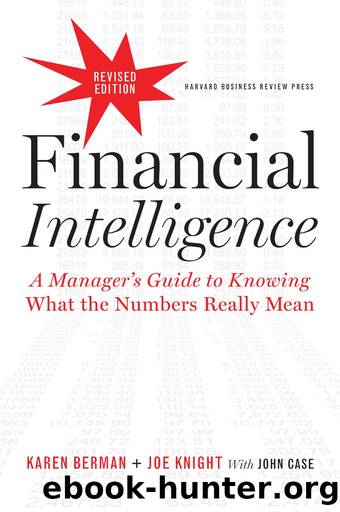B00AXS5EAK EBOK by Karen Berman & Joe Knight

Author:Karen Berman & Joe Knight [Berman, Karen]
Language: eng
Format: mobi
Published: 0101-01-01T00:00:00+00:00
18
How Cash Connects with Everything Else
Once youâve learned to read the cash flow statement, you can simply take it the way it comes and inspect it for what it tells you about your companyâs cash situation. Then you can figure out how you affect itâhow you as a manager can help better the businessâs cash position. Weâll spell out some of these opportunities in chapter 19.
But if youâre the type of person who enjoys a puzzleâwho likes to understand the logic of what youâre looking atâthen stick with us through this chapter. Because it may have already dawned on you: you can calculate a cash flow statement just by looking at the income statement and two balance sheets.
The calculations arenât hard: they involve no more than adding and subtracting. But itâs easy to get lost in the process. The reason is that accountants donât just have a special language and a special set of tools and techniques; they also have a certain way of thinking. They understand that profit as reported on the income statement is the result of certain rules, assumptions, estimates, and calculations. They understand that assets as reported on the balance sheet arenât âreallyâ worth what the balance sheet says, again because of the rules, assumptions, and estimates that go into valuing them. But accountants also understand that the art of finance, as we have called it, doesnât exist in the abstract. Ultimately, all those rules, assumptions, and estimates have to provide us with useful information about the real world. And since in finance the real world is represented by cash, the balance sheet and the income statement must have some logical relationship to the cash flow statement.
You can see the connections in common transactions. For example, take a credit sale of $100. It shows up as:
⢠an increase of $100 in accounts receivable on the balance sheet, and
⢠an increase in sales of $100 on the income statement
When the customer pays the bill, hereâs what happens:
⢠accounts receivable decreases by $100, and
⢠cash increases by $100
These changes both appear on the balance sheet. But because cash is now involved, the transaction affects the cash flow statement as well.
You can watch the effect of all sorts of transactions in just this manner. Say a company buys $100 worth of inventory. The balance sheet records two changes: accounts payable rises by $100 and inventory rises by $100. When the company pays the bill, accounts payable decreases by $100 and cash decreases by $100âagain, both on the balance sheet. When that inventory is sold (either intact, as by a retailer, or incorporated into a product by a manufacturer), $100 worth of cost of goods sold will be recorded on the income statement. The cash parts of these transactionsâthe original disbursement of cash to cover the $100 in accounts payable and the later receipt of cash from the sale of finished goodsâwill show up on the cash flow statement.
So all these transactions ultimately have an effect on the income statement, the balance sheet, and the cash flow statement.
Download
This site does not store any files on its server. We only index and link to content provided by other sites. Please contact the content providers to delete copyright contents if any and email us, we'll remove relevant links or contents immediately.
What's Done in Darkness by Kayla Perrin(25500)
Shot Through the Heart: DI Grace Fisher 2 by Isabelle Grey(18219)
Shot Through the Heart by Mercy Celeste(18160)
The Fifty Shades Trilogy & Grey by E L James(17774)
The 3rd Cycle of the Betrayed Series Collection: Extremely Controversial Historical Thrillers (Betrayed Series Boxed set) by McCray Carolyn(13189)
The Subtle Art of Not Giving a F*ck by Mark Manson(12912)
Scorched Earth by Nick Kyme(11831)
Stepbrother Stories 2 - 21 Taboo Story Collection (Brother Sister Stepbrother Stepsister Taboo Pseudo Incest Family Virgin Creampie Pregnant Forced Pregnancy Breeding) by Roxi Harding(11040)
Drei Generationen auf dem Jakobsweg by Stein Pia(10216)
Suna by Ziefle Pia(10185)
Scythe by Neal Shusterman(9259)
International Relations from the Global South; Worlds of Difference; First Edition by Arlene B. Tickner & Karen Smith(8608)
Successful Proposal Strategies for Small Businesses: Using Knowledge Management ot Win Govenment, Private Sector, and International Contracts 3rd Edition by Robert Frey(8419)
This is Going to Hurt by Adam Kay(7694)
Dirty Filthy Fix: A Fixed Trilogy Novella by Laurelin Paige(6453)
He Loves Me...KNOT by RC Boldt(5804)
How to Make Love to a Negro Without Getting Tired by Dany LaFerrière(5378)
Interdimensional Brothel by F4U(5304)
Thankful For Her by Alexa Riley(5161)
